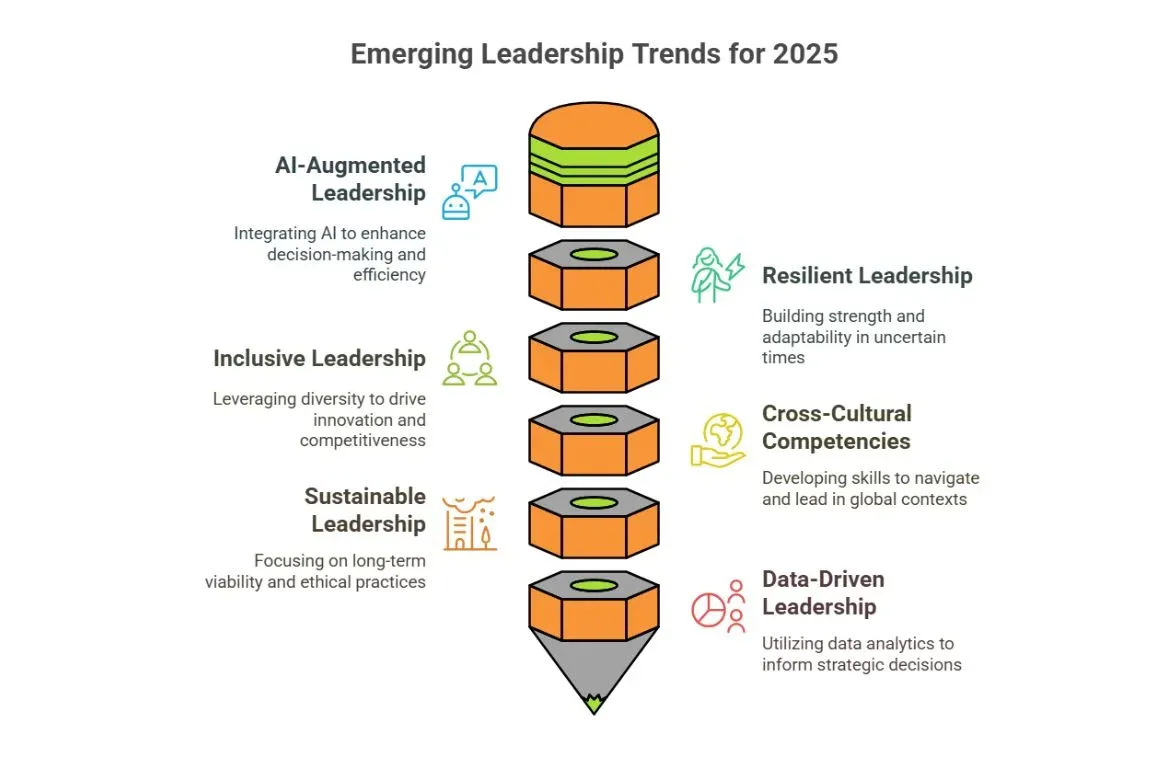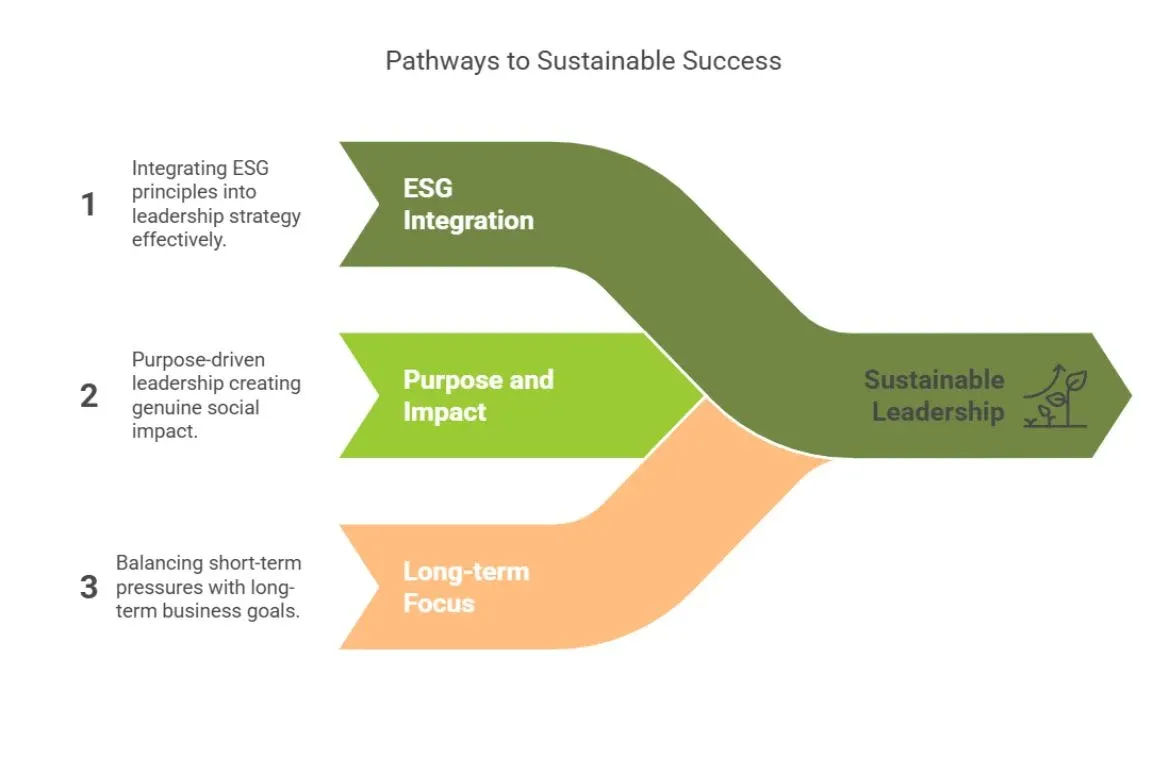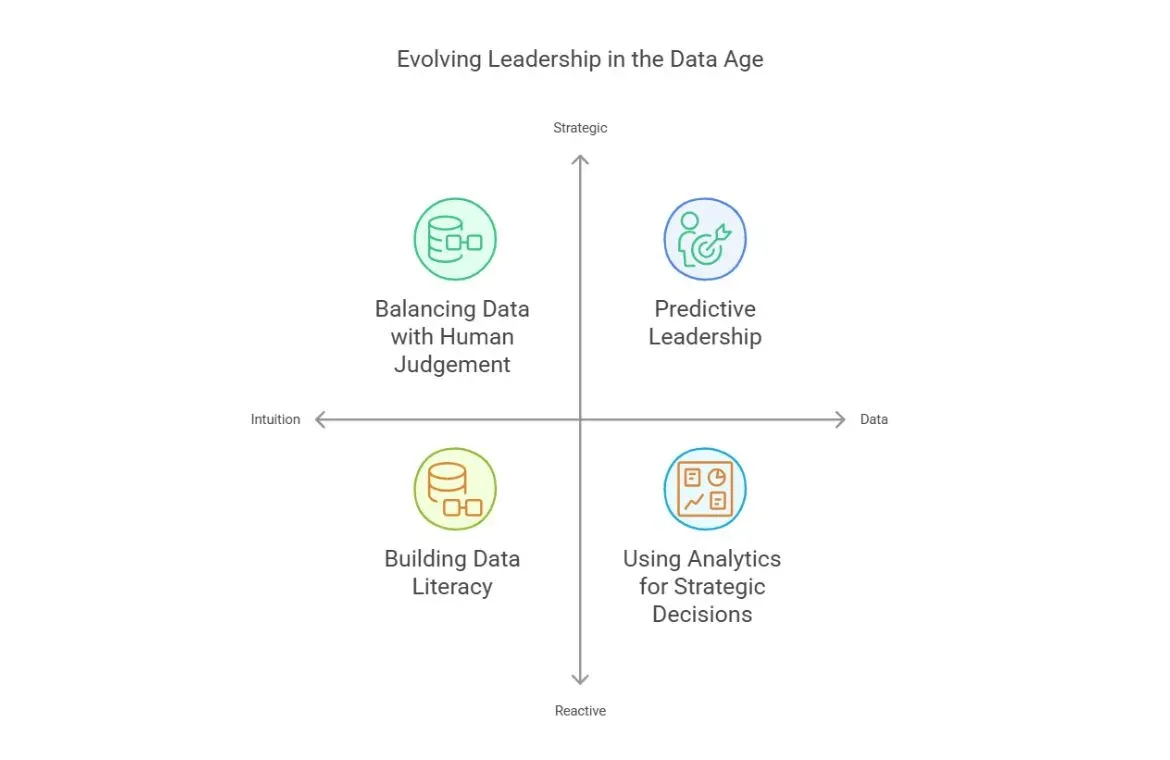Shaping the Future: The Most Impactful Leadership Trends of 2025

As we step into a new year, top leaders will navigate challenges by adopting strategies that drive innovation, enhance employee well-being, and boost agility. For leaders and aspiring leaders, it is important to know about the leadership trends in 2025.
Tomorrow's leaders must strike a perfect balance between tech advancement and human connection. This complete analysis gets into the most important leadership trends that will shape 2025.
From AI-enhanced decision-making to eco-friendly leadership, these insights are a great way to get guidance for leaders who face tomorrow's challenges. Let's get started!
Top Leadership Trends for 2025

AI-Augmented Leadership: The Human-Technology Partnership
"AI is the automation of automation, where software writes software. This is the single most powerful force of our time." — Jensen Huang, CEO of NVIDIA
AI and human leadership working together marks a basic change in how organizations work today. Companies already use AI in some part of their business. Leaders now face big opportunities and tough challenges. This partnership between AI and humans improves rather than replaces human judgment. It changes how we lead at a pace we've never seen before, creating what experts now call "AI-augmented leadership."
The Rise of AI in Leadership Decision-Making
AI has changed how leaders make decisions and solve problems. Today's executives see AI as a key partner that helps them handle huge amounts of data. These tools help leaders look at past data without bias and make fewer mistakes than human judgment alone.
AI can also spot market trends early, which lets organizations prepare for what's coming next. Leaders must now find ways to use AI's analysis while keeping the human side of leadership strong.
Ethical Considerations in AI-Powered Leadership
Ethics has moved from theory to real concerns as AI becomes part of leadership. Leaders who know the ethical and legal sides of AI can find better ways to use it while protecting privacy and fairness and following rules.
Key ethical issues include:
- Algorithmic bias and fairness: Good leaders must check that AI decisions don't create or continue bias. They need diverse data and regular system checks.
- Transparency and accountability: Some AI systems work like "black boxes," making it hard to see how they decide things. Leaders need clear rules about who's responsible, especially for big decisions.
- Data privacy and security: AI can process lots of personal data, so leaders must protect privacy and prevent data breaches. This keeps ethics strong and follows laws like GDPR.
- Workforce impact management: Good leaders think about how AI affects people and make sure workers can learn new skills if needed.
Trust grows when leaders are open about AI use, show how it helps workers do meaningful work, and teach AI skills. Organizations that use AI ethically adapt better to changes and find new opportunities.
Building Digital Literacy Among Leadership Teams
Digital literacy has become a basic skill that leadership teams must have.Leaders who understand digital tools can use data better, keep systems safe, and create specific ways to innovate.
Digital skills help leaders do more than just use technology. They can steady portfolios by finding real insights in big data. Their choices come from facts, not just gut feelings, which leads to better results.
Balancing Automation with Human Connection
Leaders must integrate AI while maintaining human relationships. Emotional intelligence remains vital, as AI lacks true understanding. AI enhances leadership but doesn’t replace it, freeing leaders to focus on people and strategy. Clear ethical guidelines ensure AI complements human creativity rather than replacing it.
The Rise of Resilient Leadership
Resilient leaders adapt quickly, navigating challenges with strategic focus. They don’t just withstand disruption, they leverage it for growth and innovation.
Developing Adaptive Leadership Capabilities
Leadership effectiveness now depends on adaptability. The "half-life of a skill" decreases faster, so leaders must learn continuously to tackle new challenges. Adaptive leadership includes specific skills that help people stay focused when clear answers don't exist.
Key adaptive leadership capabilities include:
- Structured processes to understand and respond to change fast
- Decision-making at all levels to reduce bottlenecks
- A clear vision that connects team efforts to organizational goals
- Regular tracking of industry trends and customer behaviour
Technology advances at unprecedented speeds, and adaptive leadership needs more than just new skills. Leaders must learn continuously.
Crisis Management as a Core Leadership Skill
Crisis management has grown from a specialized skill into a fundamental leadership requirement. Staff and community members look to their leaders for support and guidance during tough times.
Leaders must be transparent in their communication during crises. They need to show confidence and unite teams around shared goals. Their emotional intelligence helps teams handle the natural emotional responses that come with change and uncertainty.
Leading Through Economic Volatility
Economic uncertainty creates unique challenges that need both flexibility and discipline. Global economic changes force leaders to make tough decisions quickly. Today's dynamic business environment can create anxiety that affects workers' mental health, productivity, and retention.
Inclusive Leadership as a Competitive Advantage
"The function of leadership is to produce more leaders, not more followers." — Ralph Nader, American political activist, author, and attorney
Teams with diverse backgrounds and inclusive leaders perform better than their counterparts in competitive business environments. Organizations now recognize this capability as crucial to their success. Leadership trends have changed toward inclusivity, which reshapes how organizations handle talent management and strategic decisions.
Fostering Psychological Safety in Diverse Teams
Psychological safety forms the foundation of inclusive leadership. Team members believe they can express ideas, questions, or concerns without fear of embarrassment or retaliation. Leaders can build psychological safety by:
- Setting up meetings as spaces to share information and ideas rather than judge
- Asking for different points of view through genuine questions
- Seeing differences as valuable sources of breakthroughs
- Listening deeply to understand varied viewpoints
These practices help team members from different backgrounds contribute fully, which unlocks creative potential and drives competitive advantage as markets change faster.
Measuring the Effect of Inclusive Leadership Practices
Organizations need specific metrics to verify inclusive leadership's competitive advantage. Companies with inclusive leaders perform better because this leadership style encourages diverse thinking, strengthens team collaboration, and stimulates breakthroughs.
Key performance indicators for measuring inclusive leadership include:
- Employee engagement reflects how inclusive leadership makes teams feel valued, heard, and empowered.
- Retention rates, especially for underrepresented groups, highlight potential inclusivity gaps that impact competitiveness.
- Tracking career progression and business outcomes ensure inclusive leadership drives productivity, innovation, and growth.
Cross-Cultural Leadership Competencies
Global marketplace connections have made cross-cultural leadership skills essential rather than optional. Studies highlight how culturally sensitive leadership reshapes inclusivity, boosts communication, and drives breakthroughs in global workplaces.
Leaders can build cross-cultural competencies through cultural intelligence (CQ), which equips leaders with adaptability, empathy, and communication skills to navigate diverse environments.
Addressing Unconscious Bias in Leadership Decisions
Unconscious biases influence decisions and interactions, impacting organizational effectiveness. Progressive companies integrate bias training into leadership development, fostering awareness, inclusivity, and accountability to leverage diversity as a competitive advantage.
Sustainable Leadership: Beyond Environmental Concerns
Sustainable leadership has evolved into a detailed business approach that creates lasting value. Today's executives understand that ecological, social, and economic health cannot be separated when building successful organizations.

Integrating ESG Principles into Leadership Strategy
Environmental, Social, and Governance (ESG) principles have become crucial elements of leadership strategy. Organizations cannot succeed with isolated ESG plans. These principles need integration at every level, from mission and vision to values, strategy, and planning. This integration builds the foundation for sustainable, long-term business value.
Leading with Purpose and Social Impact
Purpose-driven leadership creates genuine social impact beyond maximizing profits. Organizations that weave purpose throughout their operations connect better with employees, customers, and communities.
Employees and consumers have different views about population priorities. Leaders must focus on uniting priorities:
- Fair wages and safe working conditions
- Authentic action over empty words
- Measurable improvement verified through data
- Co-creation of solutions with stakeholders
Companies lose credibility when they treat purpose as just marketing. The focus has moved to calculating impact through specific, measurable metrics that show real outcomes.
Long-term Thinking in Short-term Business Environments
Modern leadership must balance immediate pressures with future goals. Evidence shows long-term thinking substantially outperforms the competition. It creates jobs, builds public trust, and rewards shareholders.
Successful long-term leadership creates purpose beyond profits. It turns that purpose into strategy with board and investor support. It encourages cultures focused on long-term profitable growth.
Sustainable leadership builds systems for long-term success while staying flexible enough to handle short-term challenges.
Data-Driven Leadership: Beyond Intuition
Data analytics has revolutionized decision-making at all organizational levels, which has fundamentally changed the modern leadership landscape. Most employees will naturally use data to support their work by 2025.

1. Using Analytics for Strategic Decisions
Leaders leverage analytics for strategic advantage, replacing guesswork with data-driven experiments. Retailers use tools like Hadoop and Tableau to refine inventory, customer segmentation, and marketing.
2. Balancing Data with Human Judgement
While data enhances decision-making, human intuition remains essential for handling ambiguity. Leaders must challenge biases and integrate insights beyond raw analytics.
3. Predictive Leadership for Future Trends
Foresight planning helps leaders navigate uncertainty by exploring multiple scenarios. Predictive analytics will soon preempt leadership challenges, shifting the role from forecaster to strategist.
4. Building Data Literacy in Leadership
Leaders must develop data literacy to make informed decisions and drive a data-driven culture. Overcoming resistance to change requires structured training and mindset shifts.
Conclusion
The business world has seen dramatic changes in leadership by 2025. Technology advances, worldwide uncertainty, and new workplace patterns have reshaped how leaders work.
Modern leaders need to understand both tech capabilities and what people want.
Leaders today need specific skills to succeed that can be developed by opting a formal education. AI for leaders is a strategic course for leaders to leverage AI in business and drive organizational success.
With the need to understand digital technology to make smart choices about new tools. The digital business leadership course offered by IIM Calcutta. A future-focused leadership program designed for aspiring and current business leaders, CXOs, and entrepreneurs to master strategic frameworks for harnessing AI and digital technologies for a competitive edge.
FAQs
Q1. What are the key leadership trends expected to shape 2025?
AI-augmented leadership, resilient leadership in uncertain times, inclusive leadership as a competitive advantage, sustainable leadership beyond environmental concerns, and data-driven leadership are expected to be the most impactful trends shaping leadership in 2025.
Q2. How can leaders effectively balance AI integration with human connection?
Leaders should leverage AI for data analysis and routine tasks while prioritizing emotional intelligence, empathy, and personal relationships. Establishing clear guidelines for AI use, fostering cognitive diversity, and creating psychological safety for teams to challenge AI outputs are crucial strategies.
Q3. Why is inclusive leadership becoming increasingly important?
Inclusive leadership fosters diverse thinking, strengthens team collaboration, and fuels innovation. Organizations with inclusive leaders consistently outperform those without, as they create environments where all team members can contribute their unique perspectives and ideas.
Q4. How can leaders develop resilience in the face of economic volatility?
Leaders can build resilience by developing adaptive capabilities, focusing on scenario planning rather than rigid strategies, and cultivating an opportunity-seeking mindset. Practicing psychological resilience techniques and creating stability amidst change is also crucial.
Q5. What role does data literacy play in effective leadership?
Data literacy is essential for leadership effectiveness in 2025. It enables leaders to leverage analytics for strategic decision-making, balance data with human judgment, and anticipate future trends.

TalentSprint
TalentSprint is a leading deep-tech education company. It partners with esteemed academic institutions and global corporations to offer advanced learning programs in deep-tech, management, and emerging technologies. Known for its high-impact programs co-created with think tanks and experts, TalentSprint blends academic expertise with practical industry experience.



